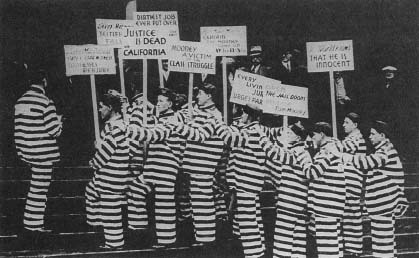Tom Mooney Trial: 1917
Letters To An Old Friend
Within two months, an old friend of Frank Oxman named Ed Rigall tried to sell the prosecutors several letters that Oxman had written him soon after the bombing, inviting him to San Francisco to swear that he had been with Oxman at the parade. It turned out that Oxman had arrived in the city four hours after the bombing and later, upon learning that the reward for information leading to the conviction of the perpetrator had climbed to $15,350, had had another friend inform Cunha that he, Oxman, was available as a witness.
Mooney's defense team got hold of the letters and published them. Subsequently the juries in Weinberg's and Rena Mooney's trials for complicity in the bomb murders found them each not guilty. Oxman was tried for subornation of perjury and acquitted. Meanwhile, Mooney sat on death row in San Quentin prison. In March 1918, the California Supreme Court upheld his conviction. Execution was set for August 23. President Woodrow Wilson appealed to the California governor, William D. Stephens. Demonstrations on Mooney's behalf were being held around the world. William Randolph Hearst, reversing the support his papers had given District Attorney Fickert, announced that Mooney should not be put to death. "Mooney Day" was celebrated nationwide in July, with speeches by top labor leaders and liberals, and the governor approved a reprieve. In November, Judge Griffin proposed a pardon and retrial. Two weeks before the scheduled hanging, the governor commuted Mooney's sentence to life imprisonment.
 During the 22 years Tom Mooney unjustly spent in prison, numerous demonstrations were held on his behalf.
During the 22 years Tom Mooney unjustly spent in prison, numerous demonstrations were held on his behalf.
For 20 more years, attempts were made to free Mooney through legal channels. But California had an outdated system for review of convictions, and the courts declared there was no procedure that could give him a new trial based on the evident perjury. Every governor during these two decades refused to take the political risk involved in freeing the radical. From his prison cell, Mooney himself interfered with his lawyers, passing up at least one chance to ask for parole.
In 1939, Democratic Governor C. L. Olson, five days after his inauguration, gave Mooney an unconditional pardon. San Francisco then saw another Market Street parade—a victory procession with Tom and Rena Mooney, with the mayor, and prominent labor leaders at the head.
Mooney lived only three more years. For most of that time, he was bedridden with illnesses contracted in prison.
—Bernard Ryan, Jr.
Suggestions for Further Reading
Frost, Richard H. The Mooney Case. Stanford, Calif.: Stanford University Press, 1968.
Gentry, Curt. Frame-up: The Incredible Case of Tom Mooney and Warren Billings. New York: W.W. Norton & Co., 1967.
Sifakis, Carl. The Encyclopedia of American Crime. New York: Facts On File, 1982.
Additional topics
Law Library - American Law and Legal InformationNotable Trials and Court Cases - 1883 to 1917Tom Mooney Trial: 1917 - One Of "the Blasters', A Surprise Witness—and A Jitney, The Clock In The Photos